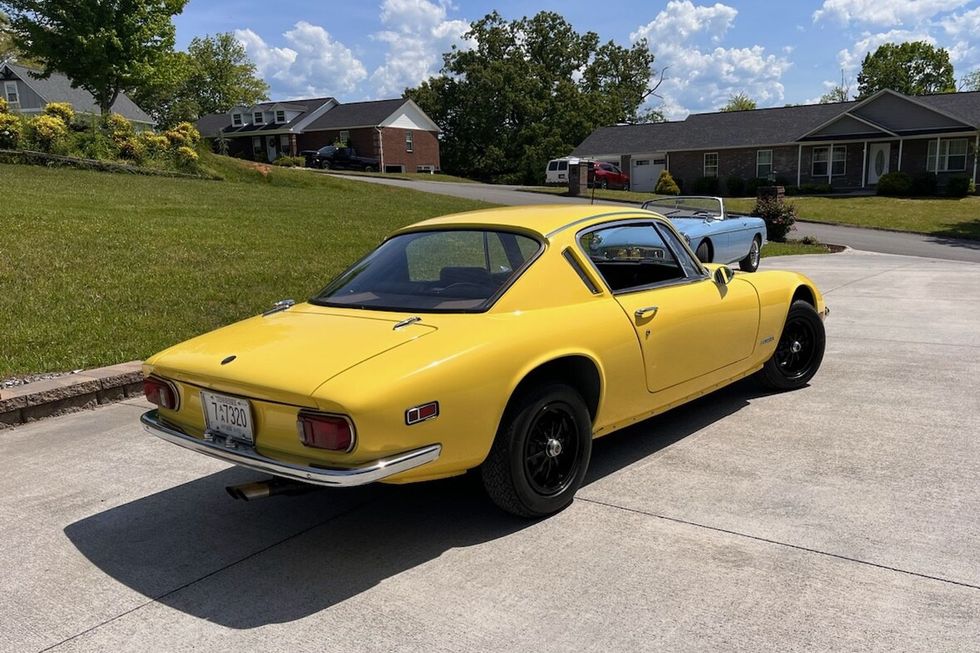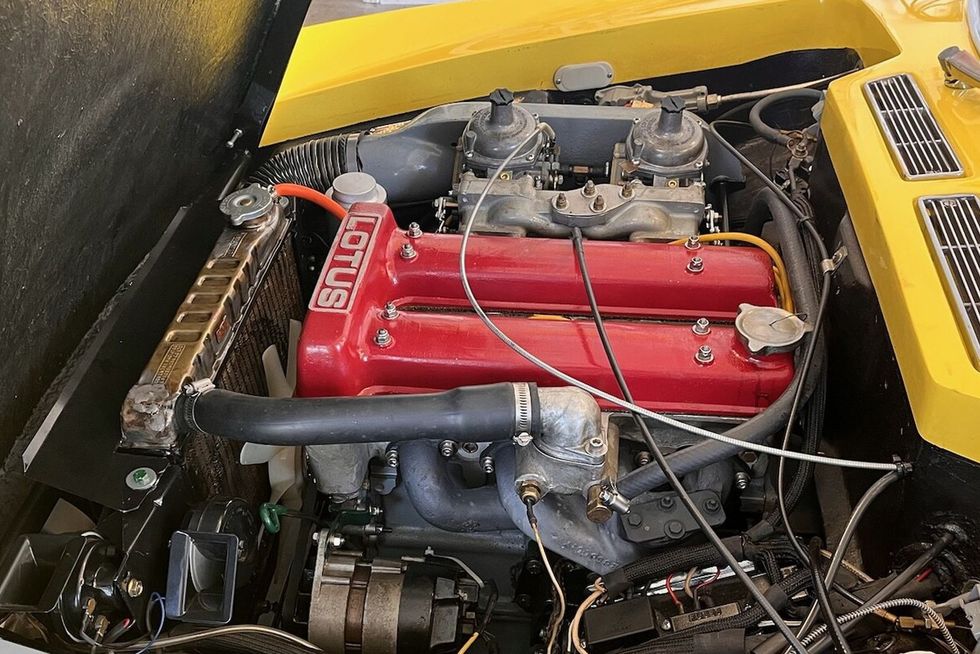50 years ago, Fiat’s affordable X1/9 brought mid-engine, open-top motoring to the masses
1972-'88 Fiat-Bertone X1/9
08/05/2022


A half-century after its debut, the Fiat X1/9 (later known as the Bertone X1/9) remains a benchmark for sophisticated sports car design in an affordable package. At launch, the Italian two-seater instantly made everything else in its price range look a decade out of date. The popularity of this mid-engine wedge helped it remain in production even after its parent company moved on, outlasting 1970s competitors like the Porsche 914 and inspiring 1980s rivals like the Pontiac Fiero and Toyota MR2.
Prior to our feature model’s introduction, Fiat’s sports cars used either the conventional front engine/rear-drive layout or rear engine/rear drive; the 1964 introduction of the transverse-mounted front engine/front drive Autobianchi Primula, designed by engineer Dante Giacosa, set the stage for the later X1/9. Giacosa’s 1968 Autobianchi G 31 show car was proof of concept: that rakish looking fastback mounted its four-cylinder driveline sideways behind the seats, achieving the mid-engine/rear-drive layout used in racecars and brought to the street by Lamborghini’s groundbreaking Miura.
With inexpensive Fiat mechanicals proven to work in this fashion, all that was left was to clothe a production sports car. Carrozzeria Bertone, which had designed and built bodies for Fiat’s 850 Spider and Ferrari V-6-powered Dino coupe, had the perfect starting point in the wedge-shaped 1969 Autobianchi A112 Runabout concept, styled by future Lamborghini Countach designer Marcello Gandini. In consideration of potential forthcoming U.S. safety regulations, the mid-engine two-seater wouldn’t be a true convertible, instead featuring a removable roof panel that bridged the windshield frame and the sturdy fixed rear buttress.
Packaging proved a strong suit of the 151-inch-long car that met the world in November 1972, with production beginning the following year. The body had refined aerodynamics and a fixed rear window that effectively reduced buffeting with the top panel off. Even with the roof stowed below the front deck, luggage space remained underneath and in the practically shaped 5.5-cu.ft. trunk behind the engine.
The spare wheel and fuel tank were positioned behind the seats; the interior design was stylish and functional. When the X1/9 arrived in America for the 1974 model year, it was powered by the 128’s SOHC 1.3-liter four-cylinder and four-speed manual gearbox. The suspension was fully independent with struts and wishbones at each corner, and boosted four-wheel disc brakes behind 13-inch wheels. European-market examples made 75 hp and could get up to 105 mph, but U.S.-spec versions made do with 66 hp and 93 mph. Bumper regulations saw the delicate original units replaced with 5-mph versions after one year. In 1979, the Strada donated its 1.5-liter engine and five-speed manual to the X1/9, helpfully improving performance. By 1981, all American-bound models used Bosch fuel injection.
It was around that same time that Fiat handed total production of the X1/9 off to Bertone, which had previously sent the bodies it made back to Fiat for driveline installation and finishing. This coachbuilder would continue to build X1/9s in smaller numbers through 1988. Bertone-badged X1/9s were then imported to America by Subaru and Yugo importer Malcolm Bricklin. By that time, around 180,000 had been sold around the world.
Engine: 1,290/1,498-cc (78.7/91.4-cu.in) SOHC I-4 with one Solex carb/fuel-injection
Horsepower: 66-75 @ 6,200-5,500 rpm
Torque: 68-79 lb-ft @ 3,600-3,000 rpm
Transaxle: Four/five-speed manual
Suspension: Independent front and rear
Brakes: Front and rear discs
Curb weight: 1,933-2,120 pounds
0-60 mph: 11.6 seconds
Top speed: 108 mph
In the early 1960s, Lotus debuted the Elan, an extremely lightweight, exceptionally small sports car. With its backbone chassis and fiberglass body, the Elan—available as a roadster or fixed-roof coupe—weighed a little over 1,500 pounds. A Ford Kent-based engine with a twin-cam, 16-valve cylinder head gave the diminutive sports car brisk performance, allowing the tiny Elan to punch well above its weight class. One thing thin the Elan was never noted for, however, was comfort, nor convenience, what with only two seats.
Enter the Elan +2, a much larger car built with the same design and engineering features, but with space for two children in the back and more comfort for the driver and front passenger. The Plus 2 debuted in 1967 and not long after an updated version, the +2S, was released with additional luxuries. Unlike the Elan, the +2 was only ever produced as a coupe. This 1972 Lotus Elan +2S 130 now offered on Hemmings Auctions appears to be a road-ready example of the first four-seater from Lotus. The “130” portion of the name came from the revised, higher-output 126-horsepower engine in the model released in the early 1970s.

Like the original, the Elan +2S featured a backbone frame and a fiberglass body. Though still compact by almost any definition of a car from the 1960s, the four-seater was bigger in every dimension. Lotus designers and engineers were tasked with creating a car that “must be capable of transporting two adults and two children 1,000 miles in comfort with their luggage.” The Plus 2’s 96-inch wheelbase was a foot longer than the original. And its overall length of 169 inches was a full two feet longer than the earlier car. Additionally, it measured 10 inches wider and two inches taller. The Plus 2 was still relatively small, itself measuring one foot shorter in both wheelbase and overall length compared to a 1965 Ford Mustang Hardtop.
Those plus-size dimensions greatly contributed to the comfort inside the car, but with road testers of the day still praising the car for maintaining the Elan’s adroit handling. Motor Sport magazine from the U.K. described the Plus 2’s steering as “incredibly light and precise.” In detail, they wrote, “The all-round independent suspension with its racing-like wishbone and link lay-out gives the car superb handling, of that there is no doubt. The glory of it is that you can whip along country lanes with their twists and turns without drama, in complete safety and not working hard while drivers in lesser vehicles struggle to keep up.”

The “big-valve” version of the 1,558-cc Lotus-designed/Ford-based twin-cam four-cylinder engine in the +2S 130 was rated at 126 horsepower and 113 lb-ft of torque, giving the car brisk acceleration, as it weighed a little over 2,000 pounds. A four-speed manual directed power to the rear wheels. Road testers of the +2S and +2S 130 models reported 0-60 mph times at right around, or even just under, eight seconds.
Technically, by 1972, there was no such model as the Elan +2S. Rather, Lotus dubbed the car the +2S 130, or alternatively the Plus 2 130. In either case, despite the obvious origins and former use of the name with the model, “Elan” was dropped from the moniker by that time. The Elan name did reappear the following year. Though Elan production ceased in 1973, the Elan +2 continued through 1974.

The notes on this 1972 Lotus Elan +2S 130 currently listed on Hemmings Auctions indicate that this Plus 2 has been restored, including a rebuild of its original engine and four-speed manual transmission, completed some 3,000 miles ago. The seller shared that the water, oil and fuel pumps were replaced, while the radiator was rebuilt. Additional fresh components are said to be the brake discs, updated Rotoflex drive couplings and wheel bearings, all as part of a chassis rebuild.
The seller reports that the fiberglass bodied was disassembled, repaired and professionally refinished before reassembly. The original brightwork was rechromed as necessary and the original glass reinstalled with new seals. Fresh Pirelli Cinturato rubber was mounted on refinished original Lotus 10-spoke alloy wheels. According to the Classic Lotus Elan Register, this +2S 130 is one of 1,879 +2S and +2S 130 models built out of a total production run of 5,139 Elan +2’s.
Take a look at this 1972 +2S 130 at Hemmings Auctions to see what a right-sized Lotus Elan looks like.

Museum-ready but built to run, this recently restored 1965 Chevrolet Chevelle 300 Funny Car is one of the first of its kind. Otherwise known as the Tiger II Chevelle, this race car is one of the rarest original AFX cars in existence and the world’s first tube chassis, center steer, full-bodied drag car. And as of this writing, it is for sale on Hemmings Marketplace.
The 1965 Chevrolet Chevelle 300 was meant to be a race car from day one. It was originally delivered to Jim and Andy Adcock of Amarillo, Texas, as a rolling chassis without a VIN number or title. Jimmy’s existing sponsorship with Esso, which used the slogan “Put a Tiger in Your Tank” for advertising, led to the building of the Tiger II.
Like most race cars, the Tiger II Chevelle was built in stages. In early-1965, Fibercraft fitted the front end with flat a fiberglass hood and fenders formed using a 1964 front end. A straight fron axle and Pontiac rear axle were installed on the original chassis and an Enderle fuel injected 376 cubic-inch small-block Chevy provided power, fed by a 30 percent load of nitromethane. Trial and error led to several wheelbase changes and many tweaks to catch more traction over the years. By mid-1966, it was already receiving an engine upgrade with a Hilborn-injected 427 cubic-inch big-block.
By 1967, the Esso sponsorship ended and the car received a new identity with blue paint and the name “Blitzer” on the side. Adcock reportedly installed a blown and injected big-block Chevy engine, but the NHRA would not allow that combination. The engine and the car were soon sold. According to history records, the car was last raced in 1973 by Jerry Rhodes under the name “Funny Money.”
For a stint, the Chevelle even ran wheelstander exhibitions with The Little Red Wagon, Hemi Under Glass and many more. The seller states that all collected documentation, including original old magazine features and historical information, is included with the sale.
Most recently, the Tiger II Chevelle underwent a five-year-long no-expense-spared restoration which was completed in late-2023. It was brought back to its original gold metallic flaked funny car state. Hot Rod Hoarders released a YouTube video about the restoration around a year ago:
HISTORIC Chevelle FUNNY CAR Found and RESTORED!youtu.be
“Most of what you see here is the original car down to the magnesium spindle mount front wheels,” writes the seller. “The Randy Bradford (Bradford’s Fiat Fuel Altered) built Hilborn-injected 427 cubic-inch big-block, Mike’s Transmission Ultimate 400, and the rest of the fresh Mark Williams drivetrain is capable of running competitively in modern nostalgia AFX, but still looks like 1966.”
This six-page feature in the January 2024 issue of All Chevy Performance magazine takes a deeper dive into the build’s history. The seller says there is another upcoming feature coming soon to the Chevy Hardcore magazine.
Original AFX cars are rarely seen in the collector car market. This historic 1965 Chevrolet Chevelle “Tiger II” is sure to fetch a lot of attention. Check out the classified ad on Hemmings Marketplace and pounce on the opportunity to own an incredibly rare hot rod.